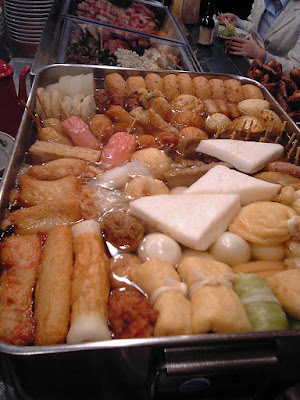Oden, hodgepodge. おでん
Various ingredients are simmered for a long time in a broth of dashi. Popular items are: slices of daikon (white radish), konnyaku (devil's tongue jelly), shelled boiled eggs, ganmodoki (type of deep-fried beancurd), yakidofu (grilled beancurd), fresh tofu, atsu-age, satsuma-age, chikuwa (fish paste rolls), kamaboko (fish paste), hanpen, cabbage rolls, potato, gobo rolls, tsukune, grilled pork, chicken, sausages, wakame (sea weed), etc.
Various ingredients are simmered for a long time in a broth of dashi. Popular items are: slices of daikon (white radish), konnyaku (devil's tongue jelly), shelled boiled eggs, ganmodoki (type of deep-fried beancurd), yakidofu (grilled beancurd), fresh tofu, atsu-age, satsuma-age, chikuwa (fish paste rolls), kamaboko (fish paste), hanpen, cabbage rolls, potato, gobo rolls, tsukune, grilled pork, chicken, sausages, wakame (sea weed), etc.

[Oden stewing at an oden stall.]
Oden is eaten hot with a little stock in the bowl and a dab of karashi (Japanese mustard). It is a typical blue-collar yatai dish, but now also going more upscale.
The full name of oden is nikomi dengaku. In the Kansai it may also be called Kanto-daki, in Nagoya Kanto-ni. This points at the Kanto origin of the dish - it began as fish dumplings from Tokyo Bay eaten with miso. These dumplings were served on wooden skewers and became known as "dengaku" after an ancient dance where performers walked on stilts. "Dengaku" was later abbreviated to "den," which became oden with the honorific "o" in front.
The full name of oden is nikomi dengaku. In the Kansai it may also be called Kanto-daki, in Nagoya Kanto-ni. This points at the Kanto origin of the dish - it began as fish dumplings from Tokyo Bay eaten with miso. These dumplings were served on wooden skewers and became known as "dengaku" after an ancient dance where performers walked on stilts. "Dengaku" was later abbreviated to "den," which became oden with the honorific "o" in front.

[Portion of oden]
Although you can easily buy the ingredients separately and make an original combination, supermarkets also sell oden sets. Besides that, fresh oden is nowadays sold in most convenience stores in Japan in wintertime. Most street stalls selling the dish have disappeared, but there are still some specialist restaurants. Where fresh oden is sold, it sits simmering in large steel containers divided into compartments for the various ingredients. New ingredients can be added all the time. Besides that, it is normally served in izakaya during winter. It is excellent with sake!